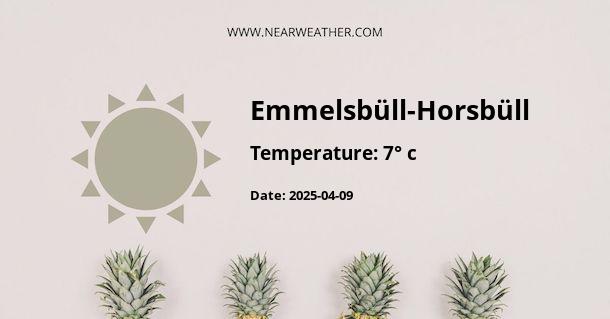Climate and Weather in Emmelsbüll-Horsbüll, Germany Throughout the Year
Emmelsbüll-Horsbüll is a small municipality located in the state of Schleswig-Holstein in northern Germany. With its proximity to the North Sea, this region exhibits an oceanic climate (Cfb according to the Köppen climate classification), characterized by mild summers and cool winters with no extreme temperatures.
Seasonal Weather Patterns
Spring
Spring in Emmelsbüll-Horsbüll commences in late March and lasts until late June. The temperature gradually rises from an average low of around 1-3°C in March to daily highs of around 16-18°C by the end of June. It is a period marked by increasing daylight and sporadic showers, with rainfall averaging about 55 mm per month.
Summer
The summer, lasting from June to August, brings the warmest weather to Emmelsbüll-Horsbüll. Temperatures during this season are comfortable, typically ranging between lows of 12°C and highs of 20°C. Despite being the warmest period of the year, summers here are moderate due to the maritime influence with the occasional rainfall, averaging 70 mm per month.
Fall
As the summer wanes, the fall season sets in from September to November. The temperatures begin to drop, with averages ranging from highs of 17°C in September to lows around 4°C in November. Precipitation increases slightly, and the region may experience stronger winds as winter approaches, with an average rainfall of 80 mm in October.
Winter
Winter months from December to February are characterized by cooler temperatures and longer nights. Daytime high temperatures hover around 3°C, while nighttime lows can drop to -1°C. Snow is infrequent but can occur. The North Sea's influence tends to keep the area slightly warmer than the interior of Germany. Average monthly precipitation during winter is at its peak with approximately 90 mm in December, which includes both rain and snow.
Year-Round Climate Data
The weather in Emmelsbüll-Horsbüll is significantly influenced by its coastal location, which helps to moderate temperature fluctuations throughout the year. Here is an overview of average temperature and precipitation:
- Annual Average Temperature: The yearly average temperature in Emmelsbüll-Horsbüll is about 8.5°C, with January typically being the coldest month and July being the warmest.
- Annual Average Precipitation: The area receives around 800 mm of precipitation annually, with the late fall and winter months being the wettest.
| Month | Average High (°C) | Average Low (°C) | Average Precipitation (mm) |
|---|---|---|---|
| January | 3 | -1 | 78 |
| February | 3 | -1 | 56 |
| March | 7 | 1 | 57 |
| April | 12 | 4 | 52 |
| May | 17 | 8 | 55 |
| June | 20 | 12 | 72 |
| July | 22 | 14 | 75 |
| August | 22 | 14 | 79 |
| September | 18 | 11 | 88 |
| October | 13 | 7 | 98 |
| November | 8 | 3 | 89 |
| December | 4 | 0 | 86 |
Note that these figures are based on long-term historical averages and are only indicative. Climate change may impact these patterns, leading to variations from year to year.
Extreme Weather and Climate Events
Though the climate of Emmelsbüll-Horsbüll is generally temperate, the area is not immune to extreme weather events. Being near the North Sea, it can sometimes be subjected to storm surges, particularly in the autumn and winter months when deep low-pressure systems pass over the sea. These events can cause local flooding and extreme wind conditions.
Climate Adaptations and Tourism Considerations
If you are planning to visit Emmelsbüll-Horsbüll, it is essential to prepare for the weather. Lightweight and breathable clothing is suited for the summer while layers, warm jackets, and waterproof gear are a must during the fall and winter. As for tourism, spring and early summer are particularly pleasant times to explore the beautiful landscapes and cultural heritage of the area. Tourists are well-advised to be prepared for some rainfall regardless of the season due to the unpredictable weather patterns associated with its coastal climate.
The Influence of Climate Change
Like many other locations worldwide, Emmelsbüll-Horsbüll may experience shifts in its climate due to global climate change. It could mean alterations in precipitation patterns, sea-level rise, more frequent storm surges, and changes in agricultural conditions. Work is ongoing in climate research to better understand and predict these changes, allowing for necessary adaptations in infrastructure, environmental conservation, and economic planning in regions like Emmelsbüll-Horsbüll and beyond.
Understanding the climate and weather of Emmelsbüll-Horsbüll involves a close look at historical data and recognition of potential future changes. Tourists, residents, and policymakers alike must consider these factors to ensure sustainable living and enjoyable experiences in this charming coastal area of northern Germany.
A - Emmelsbüll-Horsbüll's Latitude is 54.816669 & Longitude is 8.700000.
A - Weather in Emmelsbüll-Horsbüll is 7° today.
A - Climate Conditions in Emmelsbüll-Horsbüll shows overcast clouds today.
A - Humidity in Emmelsbüll-Horsbüll is 82% today.
A - Wind speed in Emmelsbüll-Horsbüll is 14.62 km/h, flowing at 291° wind direction. today.
